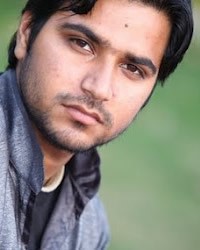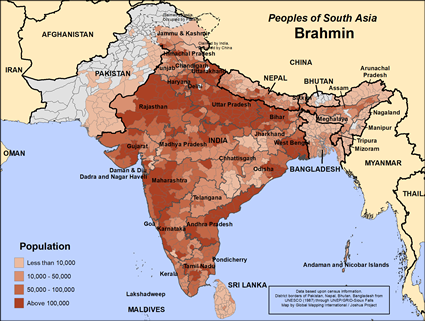Brahmin unspecified in India

Photo Source:
Anonymous
|

Map Source:
People Group Location: Omid. Other geography / data: GMI. Map Design: Joshua Project
|
| People Name: | Brahmin unspecified |
| Country: | India |
| 10/40 Window: | Yes |
| Population: | 48,723,000 |
| World Population: | 49,030,100 |
| Primary Language: | Hindi |
| Primary Religion: | Hinduism |
| Christian Adherents: | 0.00 % |
| Evangelicals: | 0.00 % |
| Scripture: | Complete Bible |
| Ministry Resources: | Yes |
| Jesus Film: | Yes |
| Audio Recordings: | Yes |
| People Cluster: | South Asia Forward Caste - Brahmin |
| Affinity Bloc: | South Asian Peoples |
| Progress Level: |
|
Introduction / History
Brahmin is a Hindu Indian caste. The English word brahmin is an anglicised form of the Sanskrit word Brahmana. Brahmin refers to the 'Supreme Self' in Hinduism or the first of the gods.
In 1931 (the last Indian census to record caste), Brahmins accounted for 4.32% of the total Indian population. Due to the diversity in language, religious and cultural traditions and practices, and the Vedic schools which they belong to, there are numerous types of Brahmins.
Brahmins are par excellence the performers of Hindu rituals, and caste status is profoundly tested by whether Brahmins are willing to perform rituals for non-Brahmin castes (i.e., if they are willing, the caste for which they do so is a high caste). But most Brahmins do not perform rituals for others (most Hindus of all castes perform daily worship rituals) and many non-Brahmins perform rituals for their own and even other caste groups."
Only a subset of Brahmins are involved in priestly duties including teaching and preaching. They have also excelled as educators, law makers, scholars, doctors, warriors, writers, poets, landowners, politicians. Modern Brahmin parents aspire for their sons to become computer programmers and engineers. Many famous Indians are Brahmins.
The history of the Brahmins is associated with the Vedic religion of early India, usually referred to as Sanatana Dharma. Brahmins first come to notice historically in the Vedic period, but how the modern caste system developed is a highly contested topic due to lack of clear data. Brahmins and kings became the dominant social and religious forces in many of the kingdoms that developed over pre-modern India. Discrimination became of a feature of the caste system with Brahmins often being assigned blame for the system. Over time, Brahmins became a powerful and influential group in India, and many discriminated against lower castes. However, in modern India some Brahmins claim reverse discrimination due to affirmative action policies of the central and state governments in India that favor lower caste groups.
Brahmins are located throughout India and there are influential Brahmins among all the major language groups. Brahmins tend to be a higher percentage in the north Indian language groups than they are among the south Indian language groups. There are small concentrations in the southern Indian states of Tamil Nadu, Karnataka and Kerala.
What Are Their Lives Like?
Brahmins are generally among the well-to-do in India and place a high value on education. (Thus, an inordinate percentage of Brahmins are among the Hindus who have migrated to the West.) Probably most still perform daily worship rituals, but the growing forces of secularization and globalization in India are strongest among the Brahmins. Most are vegetarian but some groups eat some meat, particularly fish, and many individuals even from vegetarian Brahmin groups are now eating meat (rarely beef, and often meat eating is surreptitious). Discerning opinions and heart attitudes is difficult, but it seems that only a small minority of today's Brahmins would uphold what was once considered Brahmin orthodoxy: that Brahmins are better by birth than all other peoples.
What Are Their Beliefs?
They see themselves as the preservers and teachers of Hinduism. Modern Brahmins do not espouse a doctrine of their superiority by birth above other peoples. Many are now secularists. But most Brahmins respect the ancient (and many not-so-ancient) traditions of their forefathers. Some work to synthesize modern science and Hindu beliefs and practices. There are hundreds of "denominations" of Hinduism and Brahmins have a presence in many; so it is not easy to generalize on what Brahmins believe. Some would be devotees of Vishnu or his avatars of Krishna or Ram, some would be devotees of Shiva, and some would be devotees of the goddess in one of her manifestations. Others are followers of modern gurus. Few today have seriously studied, let along memorized, the ancient Vedas; but one is more likely to find a person knowledgeable about the Vedas and other Hindu texts and teachings among Brahmins than among any non-Brahmin caste group.
What Are Their Needs?
Brahmins need to set aside status and education and look to the cross and the empty grave.
Prayer Points
Brahmins are seen as knowledgeable and enlightened; pray for the light of the gospel to bring the knowledge of Christ to them.
Pray for wisdom for Christ's disciples who befriend and share faith with Brahmins.
Pray that the true God will reveal himself to this community and use Brahmins to preach and teach about Jesus Christ.
Pray there will soon come a day when hundreds of Brahmins disciple others in the ways of Jesus Christ.